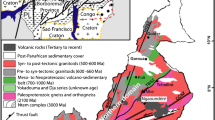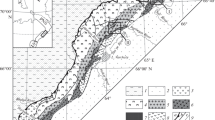Summary
In order to shed some light on the timing of metamorphic and deformational processes operating during the late stages of exhumation in the Attic-Cycladic Crystalline Belt, the contact metamorphism around Miocene granitoids was studied on Tinos. Based on the occurrence of biotite, plagioclase, diopside and scapolite, four mineral zones were mapped in the thermally overprinted area. An attempt was made to constrain relative temperature variations across the contact aureole by application of tourmaline-biotite geothermometry. While part of the calculated temperatures are broadly in accordance with the mapped mineral isograds of the aureole, temperatures far too low were obtained for certain areas. The latter may be explained by retrograde cation exchange in biotite and refractory behaviour of tourmaline but may also be attributed to systematic shortcomings of this method. New petrological and isotopic data suggest that samples from the outer aureole mostly consist of regional metamorphic phengite with ages unaffected by the thermal overprint. This renders phengite dating unsuitable to determine timing of the contact metamorphism. The hypothesis of cryptic contact metamorphic effects on the radiogenic isotope systems of white mica outside the mapped contact aureole could not be substantiated. Reliable age information for this event is provided by biotite, because most of this phase formed during contact metamorphism and inherited components only cause minimal error on the ages. In the eastern aureole, the thermal overprint is dated at about 14 Ma, corresponding to previously published geochronological results for the granitoids. Younger biotite ages of samples from the western aureole (8–10 Ma) possibly date deformation that affected the marginal parts of the main intrusion. Alternatively, the younger ages may indicate a different cooling history in this part of the contact aureole, caused by an undated magmatic pulse within a composite pluton. The Sr isotope characteristics of regional and contact metamorphic metabasic rocks cannot be distinguished. Thus, the intrusion-related infiltration of large amounts of fluids having a 87Sr/86Sr ratio different from the country rocks can be ruled out.
Zusammenfassung
Um Metamorphose- und Deformationsvorgänge im Spätstadium der Exhumierung des Attisch-kykladischen Kristallins zu charakterisieren, wurde die kontaktmetamorphe Überprägung in der Umrandung eines miozänen Intrusivkörpers auf Tinos untersucht. Das Auftreten von Biotit, Plagioklas, Diopsid und Skapolith erlaubt die Untergliederung der Kontaktaureole in vier Mineralzonen. Während das Turmalin-Biotit-Geothermometer für manche Teile der Aureole realistische Temperaturabschätzungen lieferte, ergaben sich für andere Bereiche oftmals viel zu niedrige Werte. Diese niedrigen Temperaturen können einerseits durch eine Kombination von retrogradem Kationenaustausch im Biotit und refraktärem Verhalten des Turmalins erklärt werden; andererseits können jedoch auch systematische Fehler dieser Methode nicht ausgeschlossen werden. Die Hypothese, dass die radiogenen Isotopensysteme von Hellglimmern auch außerhalb der kartierten Kontaktaureole von der Intrusion betroffen wurden, konnte nicht bestätigt werden.
Petrologische Daten und Rb-Sr-Datierungen belegen, dass Hellglimmer aus der äußeren Kontaktaureole regionalmetamorphe Zusammensetzungen und Alter überliefern. Der Zeitpunkt der thermischen Überprägung kann aber durch die Datierung von Biotit bestimmt werden, da diese Phase im wesentlichen eine kontaktmetamorphe Neubildung ist. Für den östlichen Teil der Kontaktaureole wurden Biotit-Alter von ca. 14 Ma ermittelt, die mit Abkühlaltern für die Hauptintrusion übereinstimmen. Jüngere Biotit-Alter für Proben aus der westlichen Granitumrandung (8–10 Ma) könnten auf ein Deformationsereignis zurückgehen, das auch die Randbereiche des Granits erfasste. Diese Alter könnten aber auch eine unterschiedliche Abkühlgeschichte in diesem Teil der Aureole belegen, die auf eine bisher nicht datierte Intrusion innerhalb eines komplexen Plutons zurückgehen. Die Sr-Isotopie von kontakt- und regionalmetamorphen Metabasiten unterscheidet sich nicht. Damit kann eine durch die Intrusion bedingte Infiltration größerer Fluidmengen mit deutlich unterschiedlichem 87Sr/86Sr-Verhältnis ausgeschlossen werden.
Similar content being viewed by others
Author information
Authors and Affiliations
Additional information
Received June 10, 1999; revised version accepted December 6, 1999
Rights and permissions
About this article
Cite this article
Bröcker, M., Franz, L. The contact aureole on Tinos (Cyclades, Greece): tourmaline-biotite geothermometry and Rb-Sr geochronology. Mineralogy and Petrology 70, 257–283 (2000). https://doi.org/10.1007/s007100070006
Issue Date:
DOI: https://doi.org/10.1007/s007100070006




